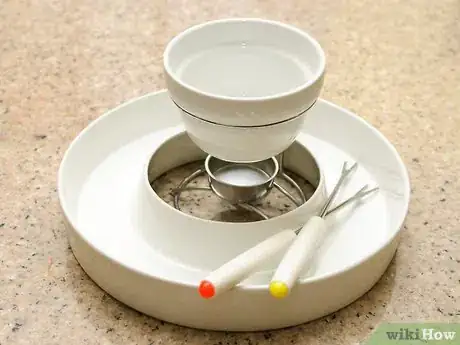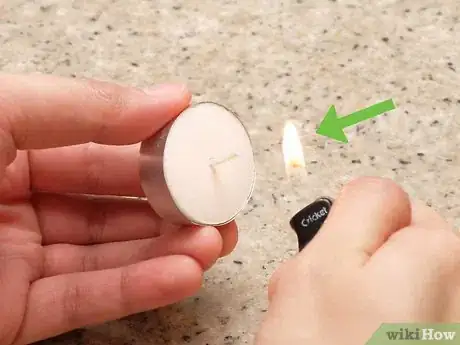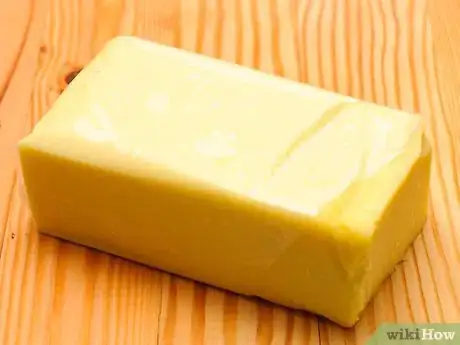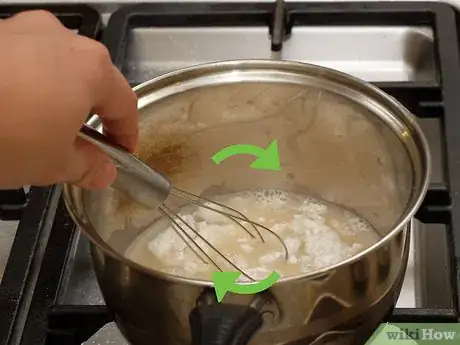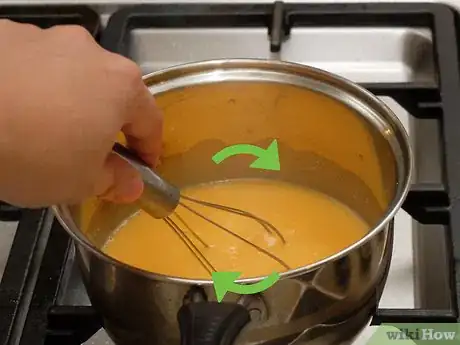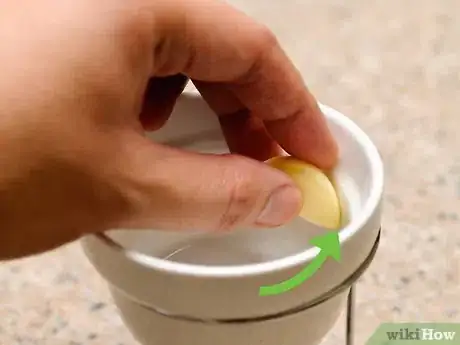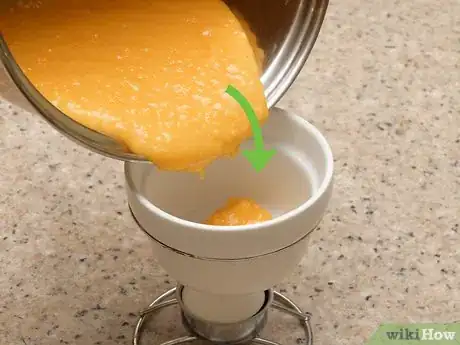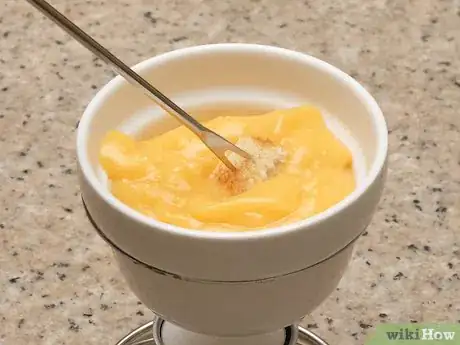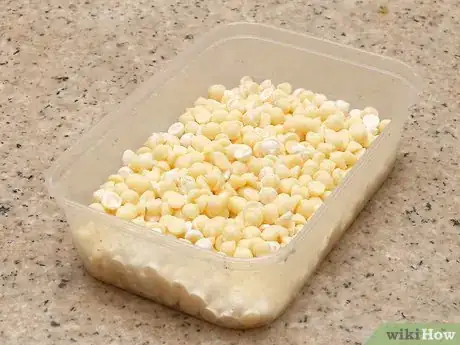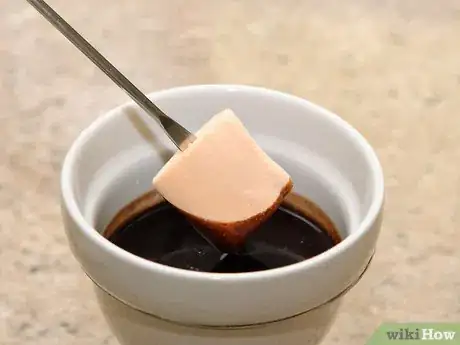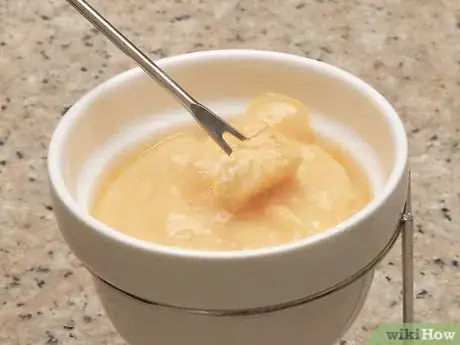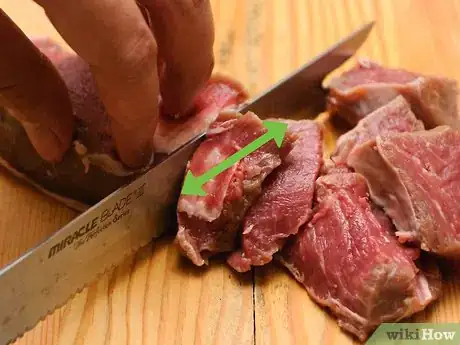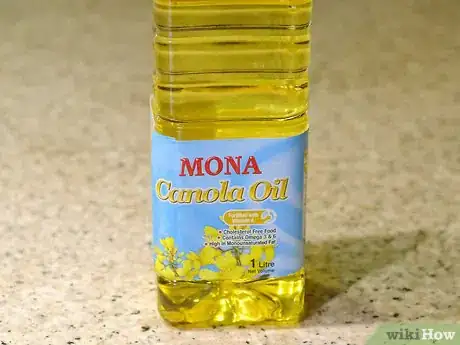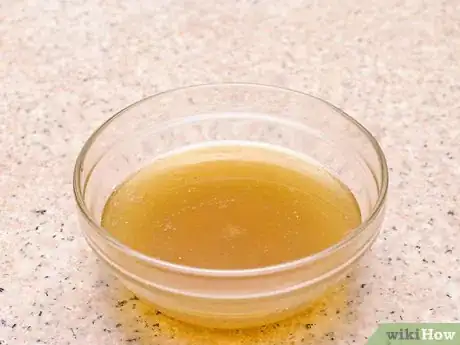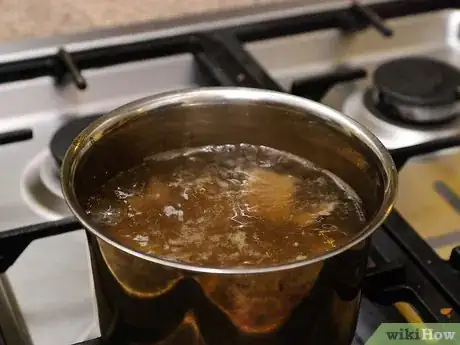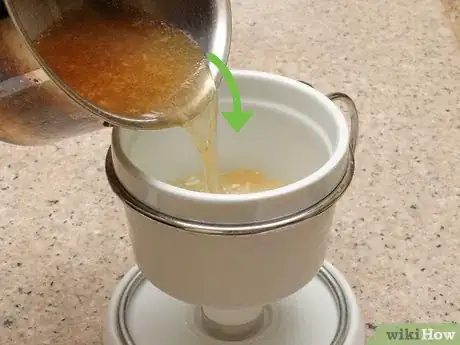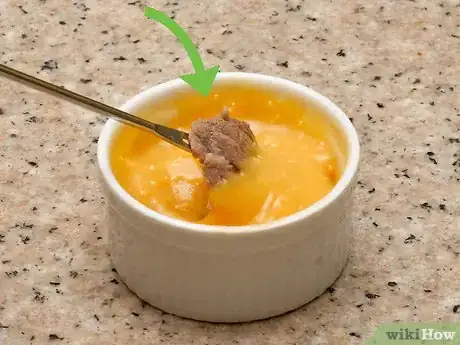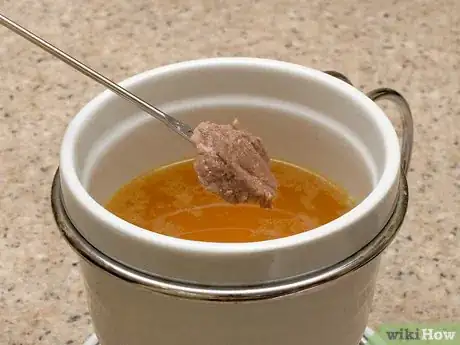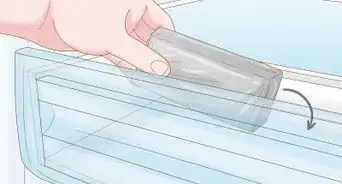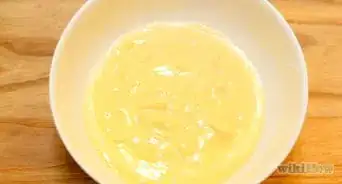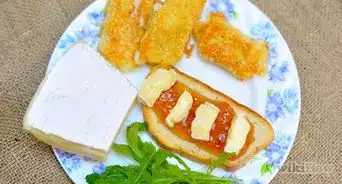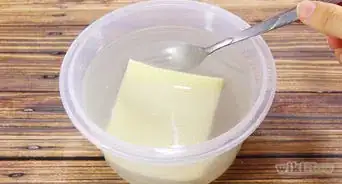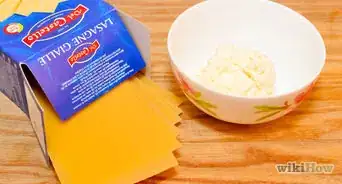wikiHow is a “wiki,” similar to Wikipedia, which means that many of our articles are co-written by multiple authors. To create this article, volunteer authors worked to edit and improve it over time.
There are 7 references cited in this article, which can be found at the bottom of the page.
This article has been viewed 37,433 times.
Learn more...
Fondue is both fun and classy, but for someone who has never made it, the idea can be a little intimidating. You can pick from cheese, dessert, oil, or broth fondues. Each type has its own peculiarities, but all of them are well-worth the effort. Keep reading to learn more.
Ingredients
- 1 lb (450 ml) shredded cheese
- 1 cup (250 ml) dry white wine OR 1 cup (250 ml) milk plus 2 to 3 Tbsp (30 to 45 ml) lemon juice
- 1 to 2 Tbsp (15 to 30 ml) cornstarch or flour
Chocolate Fondue
- 1/2 cup (125 ml) water
- 1/2 lb (250 g) dark chocolate chips
- 3.5oz (100 g) milk chocolate chips
- 1 1/4 cup (300 ml) heavy cream
- 10 large marshmallows
White Chocolate Fondue
- 11 oz (310 g) white chocolate chips
- 1/4 cup (60 ml) milk
Caramel Fondue
- 1 cup (250 ml) evaporated milk
- 2 cups (500 ml) white sugar
- 4 Tbsp (60 ml) butter
- 4 Tbsp (60 ml) corn syrup
Broth Fondue
- 6 to 8 cups (1.5 to 2 L) broth
- 6 to 8 cups (1.5 to 2 L) peanut or canola oil
Steps
Before You Begin: Lighting the Fondue Burner
-
1Choose the right type of fondue pot and fuel. The type of fondue pot you need will be determined by the type of fondue you are preparing. The right fuel is determined by this, as well.
- A cheese fondue pot will have a wide mouth and space for alcohol or gel fuel.
- Dessert fondue pots are smaller and shallower than cheese fondue pots, and they only have space for a tea light candle instead of fuel.
- Broth and oil fondue pots have a smaller mouth and are made with steel or copper. They are heated with alcohol or gel fuel.
-
2Light alcohol fuel carefully.[1] Alcohol fuel is cheap and simple, but it is highly flammable, so you need to exercise as much caution as possible.
- Make sure that the alcohol burner is completely cool before filling it.
- Never overfill the burner.
- Remove the burner and take it to a kitchen counter or kitchen sink. Carefully pour the alcohol into the burner, stopping once you see the liquid approaching the holes or mesh along the sides.
- Wipe off any fuel that may have spilled onto the outside of the burner and place it, unlit, below the fondue pot.
- Strike a match and bring it to the air holes in the burner. Make sure all the air holes are completely open, and put out and discard the match once the fuel lights up.
Advertisement -
3Try gel fuel for a slightly safer alternative. You must still exercise caution when lighting a gel burner, but is less likely to spill than liquid alcohol, so it can be a little easier to stay safe with it.
- Remove the metal mesh canister usually used for fuel and insert a gel cartridge into the remaining metal casing. Replace the top of the burner when done.
- If using pourable gel instead of a cartridge, you should still remove the mesh fuel canister. Pour the gel into the bottom of the burner and replace the top.
- Open the air holes and bring a lit match to them. When the fuel catches fire, put out the match and discard it.
-
4Know how to light a candlelit burner. Most dessert fondues require very little heat to keep the fondue in a liquid state, so a small tealight is the only source of fuel you need.
- Melt the ingredients in a double boiler on your stove before transferring it to your fondue pot.
- Place an unscented tealight candle below the fondue pot and light it with a match or lighter. Put the match out and discard it when done.
Cheese Fondue
-
1Use 1 lb (450 g) of cheese.[2] This is usually enough for four people, when used as an appetizer, or two people, when used as a main meal.
- More specifically, you need about 3.5 oz (100 g) of cheese per guest when used as an appetizer and 7 oz (200 g) of cheese per guest when used as a main meal.
- Most find that the best flavor results when multiple cheeses are mixed together.
- Cheeses that usually work well for fondue include Swiss, fontina, gruyere, emmentaler, cheddar, and monterey jack.
-
2Choose an acid to add to the cheese fondue. An acidic ingredient is necessary because it breaks up some of the stringiness of the cheese, thereby making it suitable as a dip. Wine is the standard acid of choice, and you usually need about 1 cup (250 ml) of wine per 1 lb (450 g) of cheese.
- Dry white wine is ideal. A few good options include Chenin Blanc, Dry Vermouth, Muscadet, Pinot Blanc, Pinot Grigio, Sauvignon Blanc, and Viognier.
- For a non-alcoholic option, substitute the wine for milk and add 2 to 3 Tbsp (30 to 45 ml) of lemon juice.
-
3Mix the acid with a thickener. Flour and cornstarch are the most common options. Add about 1 to 2 Tbsp (15 to 30 ml) of your chosen thickener per 1 lb (450 ml) of cheese.
- Whisk the liquid and thickener together over low heat on the stovetop to combine. The liquid should be smooth and without lumps.
-
4Combine the cheese and acid mixture on the stove. Even though you might be able to melt the cheese in your fondue pot, melting it on the stove will make it smoother.
- Shred the cheese before you melt it. Doing so will speed the process up.
- Add the cheese to the thickened liquid in your saucepan one handful at a time, stirring with each addition. Do not let the cheese boil or simmer.
-
5Rub the fondue pot with a garlic clove. Cut a clove of garlic in half and rub the exposed inside around the bottom and sides of your fondue pot.
- Rubbing the garlic on the pot will add extra flavor and aroma to the fondue without creating an overpowering garlic taste.
-
6Transfer the cheese to your fondue pot. Pour the cheese into your fondue pot, scraping the sides of your saucepan to get as much of the liquid cheese out as possible.
- Light your fondue pot using an alcohol or gel fuel.
-
7Serve the fondue with a variety of foods. Cheese fondue goes great with a variety of foods, included cubed bread, lightly steamed cauliflower or broccoli, or chunks of fried potatoes. You can also use fruit like apples or grapes.
- For fruit and vegetables, prepare enough for 1 to 2 pieces of fruit per person.
- For bread, prepare 2 to 3 servings of bread per person.
Dessert Fondue
-
1Pick your dessert fondue. Chocolate fondue is the most popular dessert option, but there are many different dessert options available, so you should experiment some to find some new favorites.
- No matter what dessert fondue you choose, you should prepare the fondue itself on the stove in a small saucepan before transferring it to your fondue pot.
- The fondue pot should already be warm before you add the fondue to it.
- After you transfer the fondue to the pot, light your candle to keep it warm.
-
2Try a traditional chocolate fondue. Chocolate fondue is rich and creamy, so it's hard to go wrong with this classic choice.[3]
- Boil 1/2 cup (125 ml) water in a small saucepan. Dump the water after it reaches a boil but do not dry the pan.
- Pour 1 1/4 cup (300 ml) of heavy cream into the same saucepan and heat over medium for about 2 minutes, just long enough for it to heat up.
- Add 1/2 lb (250 g) dark chocolate morsels and 3.5 oz (100 g) milk chocolate morsels to the hot cream and stir until melted and smooth.
- Place 10 large marshmallows in the chocolate mixture and stir until melted.
-
3Mix things up with a white chocolate fondue. White chocolate fondue can be a real treat for guests that have an especially strong sweet tooth.[4]
- Heat water in the bottom half of a double boiler using medium heat. Let it reach a slow simmer.
- Add 11 oz (310 g) white chocolate morsels to the top portion of the double boiler and combine them with 1/4 cup (60 ml) milk. Stir until melted.
- Transfer the fondue to your fondue pot.
-
4Prepare a caramel fondue. Caramel is another fondue favorite and makes a great choice for guests that may not enjoy chocolate.[5]
- Combine 1 cup (250 ml) evaporated milk, 2 cups (500 ml) white sugar, 4 Tbsp (60 ml) butter, and 4 Tbsp (60 ml) corn syrup in a small saucepan. Heat over medium, stirring frequently, until it reaches a boil.
- Allow the mixture to thicken at a boil for 5 minutes before transferring it to your warm fondue pot.
-
5Serve the fondue with a variety of dipping options. Small pieces of fruit, cake, and bread are usually your best choices for dessert fondues. Prepare 1 to 2 pieces of fruit per person or 2 to 3 servings of cake and bread per person.
- In particular, chocolate fondue goes great with strawberries, banana slices, grapes, cherries, pound cake, marshmallows, quartered oranges, pineapple, apple slices, kiwi slices, pear slices, bread, donuts, croissants, and melon, as well as various nuts.
- White chocolate fondue goes good with salted pretzel rods, pineapple, crystallized ginger, and mango slices.
- Caramel fondue works well with sliced peaches, strawberries, banana slices, grapes, cherries, pound cake, marshmallows, unsalted popcorn, pineapple, apple slices, kiwi slices, mango chunks, raspberries, pear slices, donuts, and croissants, as well as various nuts.
Broth or Oil Fondue
-
1Choose between oil and broth fondue options. Both of these options are used to cook raw pieces of meat, seafood, and vegetables, but there are a few pros and cons of each.
- Oil fondue tends to be a little unhealthier than broth fondue.
- On the other hand, oil fondue is a little more versatile because you can use it to prepare a variety of different dippings without affecting the taste of each one. Broth, however, will season the dippings with the taste of the broth.
-
2Decide which dippings you want to use. Standard options include beef, pork, lamb, chicken, seafood, and vegetables. Tender cuts of meat are usually preferred to tough cuts since the meat cooks fast.
- Prepare 1/2 lb (225 g) of meat per guest.[6]
- Prepare 6 oz (180 g) of seafood per guest.
- Prepare 1 to 2 servings of vegetables per guest.
-
3Cut the meat into bite-size servings. Each piece of meat should be cut into 3/4-inch (2-cm) pieces.
- Blot the meat with paper towels to remove excess moisture and refrigerate it until ready to use.
- Keep different types of meat separated while still raw to avoid cross-contamination.
-
4Know the best types of oil to use. If you decide to go with an oil fondue, choose an oil with a moderate smoking point. Peanut oil and canola oil are your best bets.
- If neither of these oils is available, however, you could opt for vegetable oil, grape seed oil, or clarified butter.
-
5Pick a broth that goes well with your meat choices. Since the flavor of the broth will affect the flavor of the dippings you use, choose a broth that matches or otherwise enhances the flavor of your dippings.
- Vegetable broths work for most fondue dippings and chicken broth works well for chicken, lamb, and pork. Beef broth is best for cooking beef, and seafood broth should be used for seafood.
- Prepare 6 to 8 cups (1.5 to 2 L) of broth for a single 4-serving pot.
-
6Heat the oil or broth on the stove. Pour the oil or broth into a small saucepan and heat it over medium-high heat.
- Broth should be heated to a steady boil.
- Oil should reach a temperature of 350 to 375 degrees Fahrenheit (180 to 190 degrees Celsius). Check using a deep frying thermometer or candy thermometer, or test it by dropping a piece of bread into the oil. The oil is ready when it takes 30 seconds or less to turn golden brown.[7]
-
7Transfer the liquid to your fondue pot. Carefully pour the hot liquid into an already warm fondue pot.
- Light the burner beneath the fondue pot as instructed.
- Pour the hot liquid into the fondue pot carefully to avoid burns.
- The fondue pot should be 1/2 to 2/3 full.
-
8Cook the pieces of meat and vegetables in the hot liquid. Skewer your dippings with a long fondue fork and cook them, one at a time, for a couple of minutes or until cooked through.
- Always check your meat before eating it to verify that it has fully cooked.
- Let the dippings cool slightly before eating them to avoid burning your mouth.
- Note that the liquid level may decrease over time when using broth, so you might have to pour more in as time progresses.
-
9Serve the dippings with a few fondue dips. When cooking oil or broth fondue, you would usually serve the dippings with a variety of dips. Roughly 3 to 5 dips is standard, and each guest will use about 1/2 cup (125 ml) of the various dips.
- For chicken or pork fondue, consider honey mustard or barbecue dips.
- For lamb fondue, mint dips, sour cream dips, or cottage cheese dips.
- For meatballs or beef fondue, try sweet and sour dips, mushroom dips, and mustard dips.
- For seafood dips, try tartar sauce or cocktail sauce.
-
10Finished.
Community Q&A
-
QuestionCan I use a small cast iron pot instead of the fondue pot and can I use a tea candle to keep the oil hot, or should I use a gas stove?
 Community AnswerI don't think you should use a cast iron pan but it could work if you are desperate. I would definitely use a gas stove.
Community AnswerI don't think you should use a cast iron pan but it could work if you are desperate. I would definitely use a gas stove.
Things You'll Need
- Fondue pot
- Fondue forks
- Fondue fuel (alcohol, gel fuel, or candles)
- Small saucepan
- Whisk
- Candy thermometer
References
- ↑ http://www.bestfondue.com/fondue-burner.html
- ↑ http://theshiksa.com/2011/11/07/how-to-make-the-perfect-cheese-fondue/
- ↑ http://www.bestfondue.com/easy-chocolate-fondue-recipe.html
- ↑ http://www.rachaelraymag.com/Recipes/rachael-ray-magazine-recipe-search/dessert-recipes/heavenly-white-chocolate-fondue
- ↑ http://www.bestfondue.com/caramel-fondue-recipe.html
- ↑ http://www.bestfondue.com/broth-fondue-recipes.html
- ↑ http://www.bestfondue.com/fondue-oil.html
About This Article
To make basic cheese fondue, choose 1 pound of cheese that's suitable for fondue, like Swiss, Fontina, Gruyere, or cheddar, and shred it with a cheese grater. Next, mix 1 cup of white wine with 1-2 teaspoons of flour over low heat on the stove top, stirring until it looks smooth. Then, combine the cheese and wine mixture on the stove. Finally, transfer the cheese mixture to your fondue pot and light the pot to keep the cheese warm and melted. For tips on what to serve with your cheese fondue, read on!
